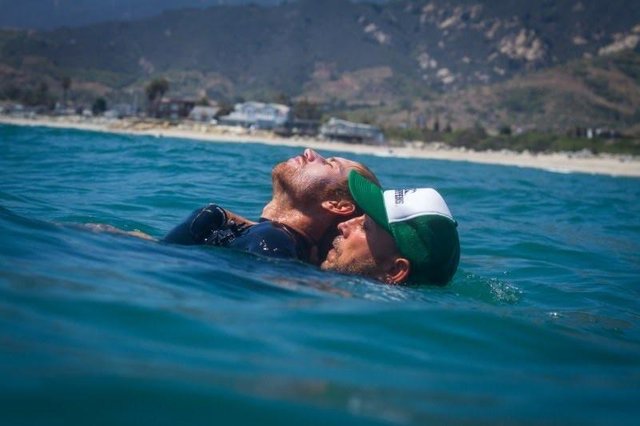How To Rescue A Drowning Swimmer 😲
How To Rescue A Drowning Swimmer

Stories of drowned swimmers saturate the news all too often. They remind us that we aren’t amphibious creatures, no matter how much we might believe we are. Virtually every body of water, excluding your average puddle (but who knows?), poses a potentially fatal threat to your land loving body. It’s a hard realization to accept. But these legs and arms of ours are much better suited for walking and running than they are for swimming. And our lungs… I won’t bother explaining further.
In as many ways as water gives life, it also takes it away. During the few years of my youth that I worked as a lifeguard, I discovered the full meaning of these words as I guzzled the same liquid I was being paid to monitor. But understanding this simple paradox isn’t enough to protect one from the perils of H2O. You must understand the basics of water safety and the techniques that will be most effective when it’s your turn to come to the rescue.

Assuming you’re an Earth loving adventurer like I am, there will be many times in your life that you will encounter some form of water, whether it be a lake, ocean, waterfall, natural pool, hot spring, Red Sea, etc. That being said, knowledge of how to rescue a drowning victim may be of some use to you (and certainly to the victim). In the below steps, I will cover everything you need to know to save a life. I promise you, this step-by-step will be much more comprehensive than The Fray’s.
Identify The Victim
When you imagine a drowning victim, what do you see? There’s a good chance the scenario you’ve imagined closely resembles that of Susan Backlinie splashing around in the water as Jaws clamps onto her lower half in the first film of the trilogy. If I’m right, you’re wrong. Although drowning victims do sometimes frantically splash as they try to stay above water, much of the time people drown subtly, going unnoticed as they sink below the surface. If a person is actively drowning, don’t expect to see their arms above the surface. Usually, only their head is visible as they silently struggle for air. If you’re close enough to see the victim’s facial expression, that should be enough. Staring death in the face leaves an unmistakable expression on one’s face.
001-Signs-of-Drowning-Pic
Call For Help
Before you consider this step a cop out, hear me out. In the situation that you need to rescue a drowning victim, use all the resources that are available to you. The only thing better than a hero is multiple heroes, and rescuing a victim from the water is much easier if you have assistance. Requesting help can render a multitude of results. By letting out a roaring, “Help me out!” these are a few of the possible outcomes:
Bystander calls 911
Doctor or nurse offers their assistance
Another rescuer dives into the water with you
Extra hands when removing victim from water
Someone hands you a floatation device (if you don’t already have one)
Now, if in the instance that you need to rescue a drowning victim you are alone, skip over the “Call For Help” step and go save a life.
Acquire A Floatation Device
Unless the drowning victim is a small child, rescuing a person without a floatation device is a task that requires very strong swimming skills. This is why it is always wise – if people are near – to ask for help. If you’re a surfer, or a surfer is in close proximity, the surfboard is probably the best life saving floatation device there is. Beach lifeguards use surfboards to rescue swimmers because they’re effective and easy: once you drag the victim onto the surface of the board, simply tell him or her to hold on tight and ride the waves to shore. Other useful floatation devices for rescuing a drowning victim are lifeguard tubes (if you can get your hands on one), lifebuoys, kick boards, or children’s floaties. Essentially, any object that will assist you in keeping the drowning victim’s head above the water will prove helpful.
life-buoy-902186_1280
Swim To Victim
This step may seem foolishly obvious, but there’s more to it than one might think. After you’ve obtained some sort of floatation device, swim toward the swimmer as fast as you possibly can. Every second counts. Never take your eyes off of the victim as you swim toward him or her. Instead of swimming with your head down in the water, taking intermittent breaths, keep your head up like a water polo player so that you always know the status of your soon to be saved drowner.
As you approach the drowning victim, come from behind. Wrapt by the chaos and fear they’re experiencing, the drowning person may try to latch onto you and pull you under if you come from the front. This seems counterintuitive, but in what appears to be the victim’s last moments alive, the last thing they’re going to be is intuitive.
Grab Onto Victim
When you reach the victim, swim up from behind and slide your arms under theirs. Grab their shoulders. The victim’s arms should be locked in between yours. This is the optimal position for carrying a drowning victim out of the water. If you have a floatation device (and it isn’t a surfboard), place it between you and the victim while you’re swimming to safety. The floatation device will make swimming a little bit easier, and will allow you to stay above water without effort. Make sure, during your swim, that the victim’s head is tilted back so their mouth and nose are out of the water.
photo_Aroyan_BA1_4512-e1432746394398
Check For Responsiveness
With the victim in your arms, ask them a few reassuring questions to make sure they’re responsive. The Red Cross recommends a simple, “Are you okay?” If you receive an answer to that question, you can go on to ask more personal questions, checking to see if your victim is experiencing shock. Ask them about their name, age, and if they came with anyone. This will give you a good idea of your victim’s condition.
Monitor The Victim Until Help Arrives
Once the victim is safely out of the water, let them rest and recover until help arrives. Never attempt to perform CPR if you aren’t trained. If I was sure it wasn’t illegal, I’d explain the steps of CPR to you here. But I’m not. What you can do, though, is check the victim’s pulse and listen to their breathing. The information you gather from these examinations may be useful to first responders when they arrive. At this point, you’re already a hero. You saved someone’s life… let that sink in. Keep your victim company, and reassure them that every little thing is going to be all right.
*The steps above only apply to active (conscious) drowning victims. For a passive (unconscious) drowning victim, your main goal will be to remove them from the water as quickly as possible, while keeping their mouth and nose above the surface and free of obstructions until help arrives

interresting thankyou x